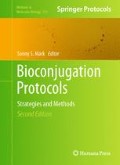Abstract
Protein–cell membrane binding interactions control numerous vital biological processes, many of which can go awry during disease onset. However, the study of these events is complicated by the complexity of the membrane bilayer. These efforts would benefit from a rapid and easily accessible method for characterizing protein–membrane recognition events. Herein, we describe a microplate-based method for the detection of protein–membrane binding that employs whole liposome immobilization using a biotin anchor. First, control studies are detailed to test for nonspecific liposome immobilization (fluorescence assay; see Subheading 3.2), and to ensure that liposomes remain intact on the microplate surface (dye leakage assay; see Subheading 3.3). Finally, a protein–membrane binding detection assay is described through the example of protein kinase Cα binding to surface-immobilized whole liposomes (see Subheading 3.4).
Access this chapter
Tax calculation will be finalised at checkout
Purchases are for personal use only
References
Cho, W. H., and Stahelin, R. V. (2005) Membrane-protein interactions in cell signaling and membrane trafficking, Ann. Rev. Biophys. Biomol. Struct. 34, 119–151.
Lemmon, M. A. (2008) Membrane recognition by phospholipid-binding domains, Nature Rev. Mol. Cell Biol. 9, 99–111.
Cho, W. W., Bittova, L., and Stahelin, R. V. (2001) Membrane binding assays for peripheral proteins, Anal. Biochem. 296, 153–161.
Chan, Y. H. M., and Boxer, S. G. (2007) Model membrane systems and their applications, Curr. Opin. Chem. Biol. 11, 581–587.
Jelinek, R., and Silbert, L. (2009) Biomimetic approaches for studying membrane processes, Mol. Biosyst. 5, 811–818.
Gong, D., Smith, M. D., Manna, D., Bostic, H. E., Cho, W., and Best, M. D. (2009) Microplate-based characterization of protein-phosphoinositide binding interactions using a synthetic biotinylated headgroup analogue, Bioconjugate Chem. 20, 310–316.
Losey, E. A., Smith, M. D., Meng, M., and Best, M. D. (2009) Microplate-based analysis of protein-membrane interactions via immobilization of whole liposomes containing a biotinylated anchor, Bioconjugate Chem. 20, 376–383.
Liu, X. Y., Yang, Q., Nakamura, C., and Miyake, J. (2001) Avidin-biotin-immobilized liposome column for chromatographic fluorescence on-line analysis of solute-membrane interactions, J. Chromatogr., B 750, 51–60.
Vermette, P., Meagher, L., Gagnon, E., Griesser, H. J., and Doillon, C. J. (2002) Immobilized liposome layers for drug delivery applications: inhibition of angiogenesis, J. Cont. Rel. 80, 179–195.
Vermette, P., Griesser, H. J., Kambouris, P., and Meagher, L. (2004) Characterization of surface-immobilized layers of intact liposomes, Biomacromolecules 5, 1496–1502.
Davidson, W. S., Ghering, A. B., Beish, L., Tubb, M. R., Hui, D. Y., and Pearson, K. (2006) The biotin-capture lipid affinity assay: a rapid method for determining binding parameters for apiloproteins, J. Lipid Res. 47, 440–449.
Kalyankar, N. D., Sharma, M. K., Vaidya, S. V., Calhoun, D., Maldarelli, C., Couzis, A., and Gilchrist, L. (2006) Arraying of intact liposomes into chemically functionalized microwells, Langmuir 22, 5403–5411.
Gutcher, I., Webb, P. R., and Anderson, N. G. (2003) The isoform-specific regulation of apoptosis by protein kinase C, Cell. Mol. Life Sci. 60, 1061–1070.
Griner, E. M., and Kazanietz, M. G. (2007) Protein kinase C and other diacylglycerol effectors in cancer, Nat. Rev. Cancer 7, 281–294.
Mackay, H. J., and Twelves, C. J. (2007) Targeting the protein kinase C family: are we there yet? Nat. Rev. Cancer 7, 554–562.
Acknowledgments
This material is based upon work supported by the National Science Foundation (NSF) under CHE-0954297 and DMR-0906752.
Author information
Authors and Affiliations
Corresponding author
Editor information
Editors and Affiliations
Rights and permissions
Copyright information
© 2011 Springer Science+Business Media, LLC
About this protocol
Cite this protocol
Smith, M.D., Best, M.D. (2011). Characterization of Protein–Membrane Binding Interactions via a Microplate Assay Employing Whole Liposome Immobilization. In: Mark, S. (eds) Bioconjugation Protocols. Methods in Molecular Biology, vol 751. Humana Press. https://doi.org/10.1007/978-1-61779-151-2_30
Download citation
DOI: https://doi.org/10.1007/978-1-61779-151-2_30
Published:
Publisher Name: Humana Press
Print ISBN: 978-1-61779-150-5
Online ISBN: 978-1-61779-151-2
eBook Packages: Springer Protocols

